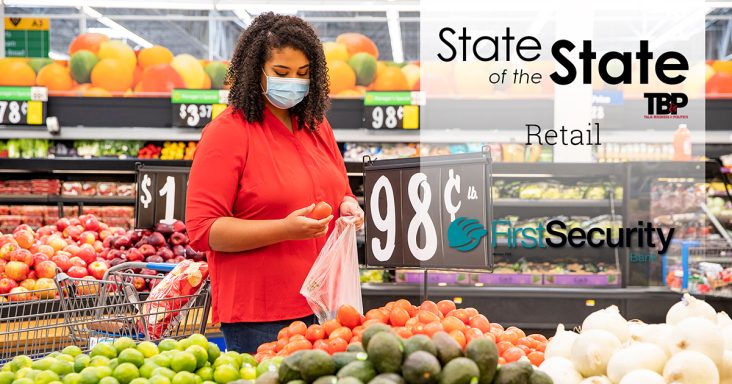State of the State 2022: Retailers expect a transitional year with higher revenue, lower margins
by January 31, 2022 2:11 pm 802 views

Two years into COVID-19 and just as retailers thought the viral end was near, the Omicron variant emerged. Although retailers posted record holiday sales gains of 11.5%, the industry face more hurdles in 2022, according to Jack Kleinhenz, chief economist with the National Retail Federation.
Kleinhenz said the Omicron variant will bring uncertainty to the economy in 2022 and could contribute to inflation, but is unlikely to cause widespread shutdowns or slowdowns which is a plus for the retail sector.
“Even with the experience of the past two years, there is no model that can predict how the economy responds to a pandemic,” Kleinhenz said.
Consumers are a major part of the retail industry and despite strong financial balance sheets for many shoppers, inflationary prices, the uncertainty of COVID and looming higher interest rates all poise real threats to economic growth throughout 2022, said Dr. Randall Waldron, professor of economics and international business at the Soderquist School of Business at John Brown University.
INEVITABLE INFLATION
Waldron said a leading indicator for inflation, the Consumer Price Index, rose to 7% in December, and the Producers Price Index was up 9.7% last year which indicates consumer prices still have room to rise through the first half of the year.
Rising prices have been cited by many consumer packaged foods companies in recent weeks and Walmart has said it will hold the line on price increases. Analysts said this will pressure gross margins in 2022 and while retailers like Walmart and Amazon have diversified their revenue opportunities, regional food retailers like Harps Foods are more likely to pass along price increases.
Harps CEO Kim Eskew told Talk Business & Politics in 2021 the 91-year-old retailer seeks expansion opportunities as consolidation continues in the traditional grocery sector. Eskew said regional grocers like Harps don’t have the scale to absorb inflationary prices. Harps operates 11 stores under the 10Box format, which takes a 10% margin over cost. Eskew said the format has done well with value shoppers before and amid COVID. Harps posted its first $1 billion year for sales revenue in 2021.
While inflation pressures gross margin and net income for retailers, it also drives higher top line revenue growth, another key metric for large mass retailers like Walmart and Target.
SUPPLY CHAIN, LABOR ISSUES
The retail industry has been hit by supply chain disruptions but Waldron said retailers and supply chain companies have been resilient and flexible during the crisis. While disruptions are expected to continue through much of 2022, Waldron said the complex retail supply chain is likely to be healthier and more reliable on the back side of COVID given business investment and due diligence during the past two years.
Kleinhenz said with the Omicron variant keeping more people at home, spending on goods rather than services is positive for retailers. He said this will also continue to fuel inflation since global supply chains are already overloaded.
Walmart with its massive global scale has been able to mitigate some of the supply chain disruptions. Walmart sought new sources, used less congested ports and even chartered its own ships to get products into stores for the holidays. Analysts said Walmart was a “winner” amid the pandemic and the company will continue to exhibit strength and play offense in 2022.
Analysts at Little Rock-based Stephens Inc. expect Walmart’s annual earnings to rise 8% next year, which follows 18% growth in fiscal 2022, which ended Jan. 31.
“Walmart is demonstrating its ability to lead. The company has played offense on numerous fronts over the last few years, and we think the company is poised to leverage its scale to lead on price and take market share while also delivering accelerated earnings growth as we move through the next year,” noted Ben Bienvenu, an analyst at Stephens Inc.
Labor constraints are also a big challenge for retailers of all sizes in 2022. Waldron said the service sector continues to suffer huge labor shortages as COVID persists. He said it will likely take higher wages to get people back to work once the COVID threat has waned. Waldron said higher wages will also push up overall prices and help to feed inflation in 2022 and beyond.
Walmart and much of the retail segment continues to invest in automation to help ease workforce shortages in certain labor intensive roles. Deliveries via drones and self-driving vehicles also are being tested by Walmart to help with labor shortfalls and reduce final-mile delivery costs.
RETAIL WINNERS
Jan Kniffen, CEO of Kniffen Worldwide, said the two Arkansas-based retailers of Dillard’s and Walmart were winners in 2021 and that is likely to repeat in 2022.
“Dillard’s is a well-run business that has not deviated from retail 101 nor been seduced by the online siren,” Kniffen said. “Dillard’s has managed to serve its loyal client base online but it has not gotten into the free delivery and returns games that can greatly diminish margins.”
He said Dillard’s has benefited from not having to take mark-downs over the past several years because of better inventory management. The retailer also saw net income rise 1,100% in the first three quarters of 2021, over pre-pandemic comparison. Kniffen said Walmart is also a big winner and the biggest threat to Amazon, and vice versa. He said Walmart and Dillard’s also benefit from being controlled by founding families owning a majority of the voting stock.
“This allows them to plan for and run long-term game plans without the risk of activist shareholders mounting takeover campaigns or leadership changes,” Kniffen said.
Editor’s note: Link here to connect to the State of the State section.
